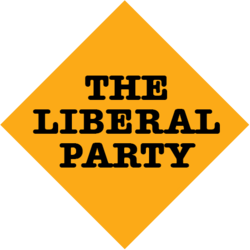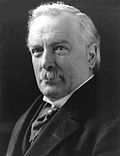Liberal Party (UK)
The Liberal Party was a liberal political party. It was one of the two big political parties in the United Kingdom in the 19th and early 20th century.[2]
 | |
| Merger of | Whigs, Radicals, Peelites |
| Merged into | Liberal Democrats |
| Headquarters | Offices at the National Liberal Club, 1 Whitehall Place, London |
| Ideology | Liberalism (British) Internal factions: • Classical liberalism • Social liberalism[1] |
| Political position | Centre |
| National affiliation | SDP–Liberal Alliance (1981–88) |
| European affiliation | Federation of European Liberal Democrats (1976–88) |
| International affiliation | Liberal International (1947–88) |
| European Parliament group | Liberal and Democratic Group (1976–85) Liberal and Democratic Reformist Group (1985–88) |
| Colours | Yellow |
The party came from an alliance of Whigs and free-trade Peelites and radicals in the 1850s. In the next 50 years it formed four governments under William Gladstone.
The party split over the issue of Irish Home Rule. It returned to power in 1906 with a landslide victory. They introduced the welfare reforms that created a basic British welfare state.
H. H. Asquith was Liberal Prime Minister between 1908 and 1916. He was followed by David Lloyd George, whose premiership lasted until 1922. At that time the coalition the party had formed with the Conservative Party in World War I came to an end.
By the end of the 1920s, the Labour Party had replaced the Liberals as the Conservatives' main rival. The party went into decline. By the 1950s, it won no more than six seats at general elections.
Apart from notable by-election victories, the party's fortunes did not improve significantly until it formed the SDP-Liberal Alliance with the newly formed Social Democratic Party (SDP) in 1981. At the 1983 General Election, the Alliance won over a quarter of the vote, but only 23 of the 650 seats it contested. At the 1987 General Election, it won less than 23% of the vote.
In 1988, the Liberal Party was renamed the Liberal Democrats with the SDP merging into it.
Prominent intellectuals associated with the Liberal Party include the philosopher John Stuart Mill, the economist John Maynard Keynes and social planner William Beveridge.
Liberal Party (UK) Media
Liberal politicians David Lloyd George and Winston Churchill enacted the 1909 People's Budget which specifically aimed at the redistribution of wealth.
The results of the 1906 election
References
- ↑ Stephen Driver (2011). Understanding British Party Politics. Polity. p. 117. ISBN 978-0-7456-4077-8. Retrieved 20 July 2013.
- ↑ Thomas Banchoff; Mitchell Smith (1999). Legitimacy and the European Union: The Contested Polity. Routledge. p. 123. ISBN 978-0-415-18188-4. Retrieved 16 July 2013.
Other websites
- Includes various publications by the Liberal Party from the 19th and 20th centuries
- 100 points in Liberal policy and of the Liberal record : facts, figures, and proposals clearly, shortly and interestingly explained ... 1912
- The work of liberalism since the great Reform Act. A summary of political history, 1832-1905
- The British Liberal party; an historical sketch by Hamilton Fyfe






